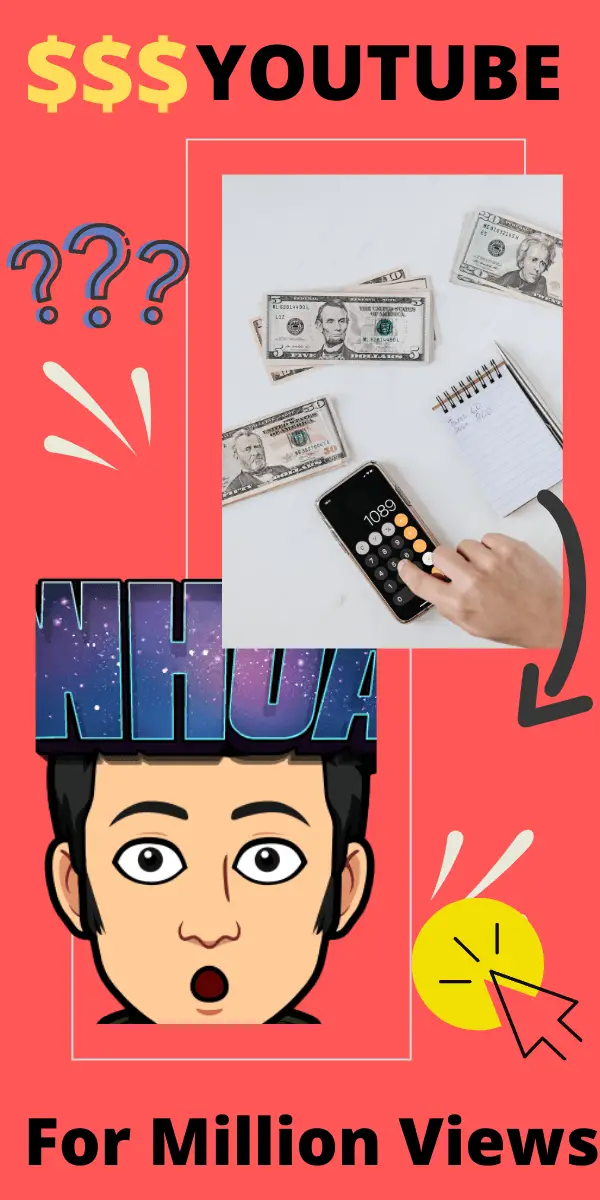How Much Youtube Pays for 1 Million Views? The amount that YouTube pays for 1 million views can vary significantly depending on a variety of factors, such as the content of the video, the country where the views are coming from, and the type of ads being shown. In general, YouTube pays creators through its Partner Program, which allows them to earn a share of the advertising revenue generated from their videos.

The actual amount that a creator earns per 1 million views can range from a few hundred dollars to several thousand dollars, depending on the factors mentioned above. Some creators may earn more or less than this amount, depending on their specific circumstances. It’s important to note that the amount a creator earns per 1 million views is not a fixed number, and can change over time based on various factors.
There are several factors that can affect the amount that YouTube pays for 1 million views of a video. These include:
- The content of the video: Videos that cover topics that are in high demand or that have a large and engaged audience are more likely to generate more revenue.
Videos that cover topics that are in high demand or that have a large and engaged audience are generally more likely to generate more revenue on YouTube. This is because these types of videos tend to attract more views and more ad impressions, which can lead to more revenue being generated.
In addition to attracting more views, videos that cover topics that are in high demand or that have a large and engaged audience may also be more attractive to advertisers. Advertisers are often willing to pay more for ad placements on videos that have a large and engaged audience, as this can help them reach a wider audience and potentially lead to more sales or conversions.
It’s worth noting that the demand for different types of content can vary over time, and what is considered to be in high demand can change. For example, during a pandemic, videos related to health and wellness may be in high demand, while in other circumstances, videos related to entertainment or technology may be more popular.
- The country where the views are coming from: YouTube pays different amounts for views depending on the country. In general, views from countries with a higher cost of living and higher advertising rates will generate more revenue.
YouTube pays different amounts for views depending on the country where the views are coming from. In general, views from countries with a higher cost of living and higher advertising rates will generate more revenue for creators. This is because the value of an ad impression can vary significantly depending on the country where it is shown.
For example, an ad impression in a country with a higher cost of living and higher advertising rates may be worth more than an ad impression in a country with a lower cost of living and lower advertising rates.
It’s worth noting that the specific amount that YouTube pays for views in different countries can vary significantly and is subject to change over time. Additionally, the specific impact of a viewer’s location on the amount of revenue that is generated can vary depending on the other factors that are involved, such as the content of the video, the type of ads being shown, and the length and quality of the video.
- The type of ads being shown: The type of ads being shown on a video can also affect the amount of revenue that is generated. For example, ads that are shown before a video starts (pre-roll ads) tend to generate more revenue than ads that are shown during a video (mid-roll ads).
The type of ads being shown on a video can affect the amount of revenue that is generated. In general, ads that are shown before a video starts (pre-roll ads) tend to generate more revenue than ads that are shown during a video (mid-roll ads). This is because pre-roll ads are typically shown to viewers before they start watching a video, which means that they have the potential to reach a larger audience. Additionally, pre-roll ads tend to be longer in duration, which can also lead to more ad impressions and higher revenue.
On the other hand, mid-roll ads are shown during a video and are typically shorter in duration. This can result in fewer ad impressions and lower revenue compared to pre-roll ads. However, mid-roll ads can still be an effective way for creators to monetize their videos and generate revenue, especially if they have a large and engaged audience that is willing to watch the ads.
It’s worth noting that the specific impact of the type of ads being shown on the amount of revenue that is generated can vary depending on the other factors that are involved, such as the content of the video, the country where the views are coming from, and the length and quality of the video.
- The length of the video: Shorter videos may generate less revenue per view because they have fewer ad impressions.
The length of a video can affect the amount of revenue that it generates. In general, shorter videos may generate less revenue per view because they have fewer ad impressions. This is because the number of ad impressions that a video generates is directly related to its length – the longer the video, the more ad impressions it is likely to have.
For example, a 10-minute video with three ad breaks will generally generate more ad impressions (and potentially more revenue) than a 5-minute video with one ad break. However, it’s worth noting that the specific impact of the length of a video on the amount of revenue that it generates can vary depending on the other factors that are involved, such as the content of the video, the country where the views are coming from, the type of ads being shown, and the quality of the video.
It’s also worth noting that the length of a video is just one factor that can affect its revenue, and there are many other factors that can also play a role. For example, videos that cover topics that are in high demand or that have a large and engaged audience may be able to generate more revenue even if they are shorter in length.
- The number of ads shown: Videos with more ad impressions will generally generate more revenue.
The number of ad impressions that a video generates can affect the amount of revenue that it generates. In general, videos with more ad impressions will generate more revenue because they have the potential to reach a larger audience and generate more clicks on the ads.
The number of ad impressions that a video generates is directly related to the number of ads that are shown and the length of the video. For example, a 10-minute video with three ad breaks will generally generate more ad impressions (and potentially more revenue) than a 5-minute video with one ad break. However, it’s worth noting that the specific impact of the number of ads shown on the amount of revenue that is generated can vary depending on the other factors that are involved, such as the content of the video, the country where the views are coming from, the type of ads being shown, and the quality of the video.
It’s also worth noting that the number of ads shown is just one factor that can affect a video’s revenue, and there are many other factors that can also play a role. For example, videos that cover topics that are in high demand or that have a large and engaged audience may be able to generate more revenue even if they have fewer ad impressions.
- The ad quality: Higher quality ads are more likely to be clicked on, which can increase the revenue generated.
The quality of the ads that are shown on a video can affect the amount of revenue that is generated. In general, higher-quality ads are more likely to be clicked on by viewers, which can lead to more revenue being generated.
There are a few factors that can contribute to the quality of an ad, including its relevance to the viewer, the clarity of its message, and its overall appeal. Ads that are well-targeted to the viewer and that clearly communicate their message are more likely to be effective and generate more revenue.
It’s worth noting that the specific impact of the quality of the ads on the amount of revenue that is generated can vary depending on the other factors that are involved, such as the content of the video, the country where the views are coming from, the type of ads being shown, and the length and quality of the video.
Conclusion:
It’s important to note that these are just some of the factors that can affect the amount of revenue that is generated from YouTube views, and the specific impact of each factor can vary.






Recent Comments